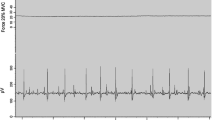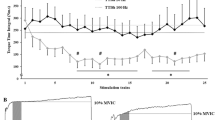Summary
The purpose of this investigation was to examine the integrity of neuromuscular transmission and impulse propagation during fatigue by examining the muscle compound action potential (M wave) in elderly and young adults. The tibialis anterior muscle of nine elderly [{ie567-1}=67.7 (SE 1.7) years] and nine young [{ie567-2}=26.7 (SE 1.2) years] adults was maximally stimulated repetitively at frequencies of 20, 30 or 40 Hz for 60 s on separate occasions. There was a significantly smaller resting M wave amplitude [7.9 (SE 0.4) mV versus 9.9 (SE 0.6) mV] and M wave area [0.038 (SE 0.005) mV s versus 0.06 (SE 0.004) mV · s] in the elderly versus the young adults respectively. Measurement of the evoked muscle contractile properties revealed significantly (P<0.05) longer twitch durations and a significantly (P<0.05) greater peak twitch torque [4.6 (SE 0.4) Nm versus 3.2 (SE 0.5) Nm] in the elderly versus the young adults, respectively. The elderly adults had a significantly greater torque decline during the 20-Hz trial; however, the decline in torque during the 30-Hz and 40-Hz trials was similar in the elderly and the young adults (30 Hz: 40%; 40 Hz: 56%). Throughout each of the stimulation trials, the decline in torque was accompanied by a significant reduction in M wave amplitude (20 Hz: 14%; 30 Hz: 53%; 40 Hz: 67%); M wave area also declined significantly during the 30-Hz (31%) and 40-Hz (53%) trials. There was no significant difference between the elderly and the young adults in the reduction in the M wave amplitude or area during each trial. The similar electrical responses of the tibialis anterior between the elderly and the young adults suggest that any age-associated changes that occur in the neuromuscular apparatus do not appear to affect the integrity of neuromuscular propagation of the development of fatigue during repetitive stimulation at these frequencies.
Similar content being viewed by others
References
Aniansson A, Grimby G, Hedberg M, Rundgren A, Sperling L (1978) Muscle function in old age. Scand J Rehabil Med 6:43–49
Aniansson A, Hedberg M, Henning G, Grimby G (1986) Muscle morphology, enzymatic activity, and muscle strength in elderly men: a follow-up study. Muscle Nerve 9:585–591
Banker BQ, Kelly SS, Robbins N (1983) Neuromuscular transmission and correlative morphology in young and old mice. J Physiol (Lond) 339:355–375
Belanger AY, McComas AJ (1981) Extent of motor unit activation during effort. J Appl Physiol 51:1131–1135
Bigland-Ritchie B, Jones DA, Woods JJ (1979) Excitation frequency and muscle fatigue: electrical responses during human voluntary and stimulated contractions. Exp Neurol 64:414–427
Botelho SY, Cander L, Guiti N (1954) Passive and active tensionlength diagrams of intact skeletal muscle in normal women of different ages. J Appl Physiol 7:93–98
Campbell MJ, McComas AJ, Petito F (1973) Physiological changes in ageing muscles. J Neurol Neurosurg Psychiatry 36:174–182
Carlson KE, Alston W, Feldman DJ (1963) Electromyographic study of aging in skeletal muscle. Am J Phys Med 43:141–145
Courtney J, Steinbach JH (1981) Age changes in neuromuscular junction morphology and acetylcholine receptor distribution on rat skeletal muscle fibres. J Physiol (Lond) 320:435–447
Davies CTM, White MJ (1983) Contractile properties of elderly human triceps surae. Gerontology 29:19–25
Davies CTM, Thomas DO, White MJ (1983) Mechanical properties of young and elderly human muscle. Acta Med Scand [Suppl] 711:219–226
DeLuca A, Mambrini M, Camerino DC (1990) Changes in membrane ionic conductances and excitability characteristics of rat skeletal muscle during aging. Pflügers Arch 415:642–644
Fahim MA, Robbins N (1982) Ultrastructural studies of young and old mouse neuromuscular junctions. J Neurocytol 11:641–656
Frolkis VV, Martynenko OA, Zamostyan VP (1976) Aging of the neuromuscular apparatus. Gerontology 22:244–279
Gutmann E, Hanzlikova V (1965) Age changes of motor endplates in muscle fibres of the rat. Gerontologia 11:12–24
Gutmann E, Hanzlikova V (1972) Basic mechanisms of aging in the neuromuscular system. Mech Ageing Dev 1:327–349
Hicks A, Fenton J, Garner S, McComas AJ (1992) M wave potentiation during and after muscle activity. J Appl Physiol 66:2606–2610
Hicks AL, Cupido CM, Martin J, Dent J (1992) Muscle excitability in elderly adults: The effects of training. Muscle Nerve 15:87–93
Hultman E, Sjoholm H (1983) Electromyogram, force and relaxation time during and after continuous electrical stimulation of human skeletal muscle in situ. J Physiol (Lond) 339:33–40
Kjeldsen K (1981) Regulation of the concentration of3H-ovabain binding sites in mammalian skeletal muscle — Effects of age, K-depletion, thyroid status and hypertension. Dan Med Bull 34:15–46
Klein C, Cunningham DA, Paterson DH, Taylor AW (1988) Fatigue and recovery contractile properties of young and elderly men. Eur J Appl Physiol 57:684–690
Klitgaard H, Ausoni S, Damiani E (1989) Sarcoplasmic reticulum of human skeletal muscle: age-related changes and effect of training. Acta Physic] Scand 137:23–31
Larsson L, Karlsson J (1978) Isometric and dynamic endurance as a function of age and skeletal muscle characteristics. Acta Physiol Scand 104:129–136
Larsson L, Salviati G (1989) Effects of age on calcium transport activity of Sarcoplasmic reticulum in fast- and slow-twitch rat muscle fibres. J Physiol (Lond) 419:253–264
Larsson L, Sjodin B, Karlsson J (1978) Histochemical and biochemical changes in human skeletal muscle with age in sedentary males, age 22–65 years. Acta Physiol Scand 103:31–39
Lexell J, Henriksson-Larsen K, Winblad B, Sjostrom M (1983) Distribution of different fiber types in human skeletal muscles: effects of aging studies in whole muscle cross sections. Muscle Nerve 6:588–595
McDonagh MJN, White MJ, Davies CTM (1984) Different effects of ageing on the mechanical properties of human arm and leg muscles. Gerontology 30:49–54
Merton PA (1954) Voluntary strength and fatigue. J Physiol (Lond) 128:553–563
Moritani T, Muro M, Kijima A (1985) Electromechanical changes during electrically induced and maximal voluntary contractions: electrophysiologic responses of different muscle fiber types during stimulated contractions. Exp Neurol 88:471–483
Smith DO, Weiler MH (1987) Acetylcholine metabolism and choline availability at the neuromuscular junction of mature adult and aged rats. J Physiol (Lond) 383:693–709
Tucek S, Gutmann E (1973) Choline acetyltransferase activity in muscles of old rats. Exp Neurol 38:349–360
Vandervoort AA, McComas AJ (1986) Contractile changes in opposing muscles of the human ankle joint with aging. J Appl Physiol 61:361–367
Wokke JHJ, Jennekens FGI, van den Oord CJM, Veldman H, Smit LME, Leppink GJ (1990) Morphological changes in the human end plate with age. J Neurol Sci 95:291–310
Author information
Authors and Affiliations
Rights and permissions
About this article
Cite this article
Cupido, C.M., Hicks, A.L. & Martin, J. Neuromuscular fatigue during repetitive stimulation in elderly and young adults. Europ. J. Appl. Physiol. 65, 567–572 (1992). https://doi.org/10.1007/BF00602367
Accepted:
Issue Date:
DOI: https://doi.org/10.1007/BF00602367




